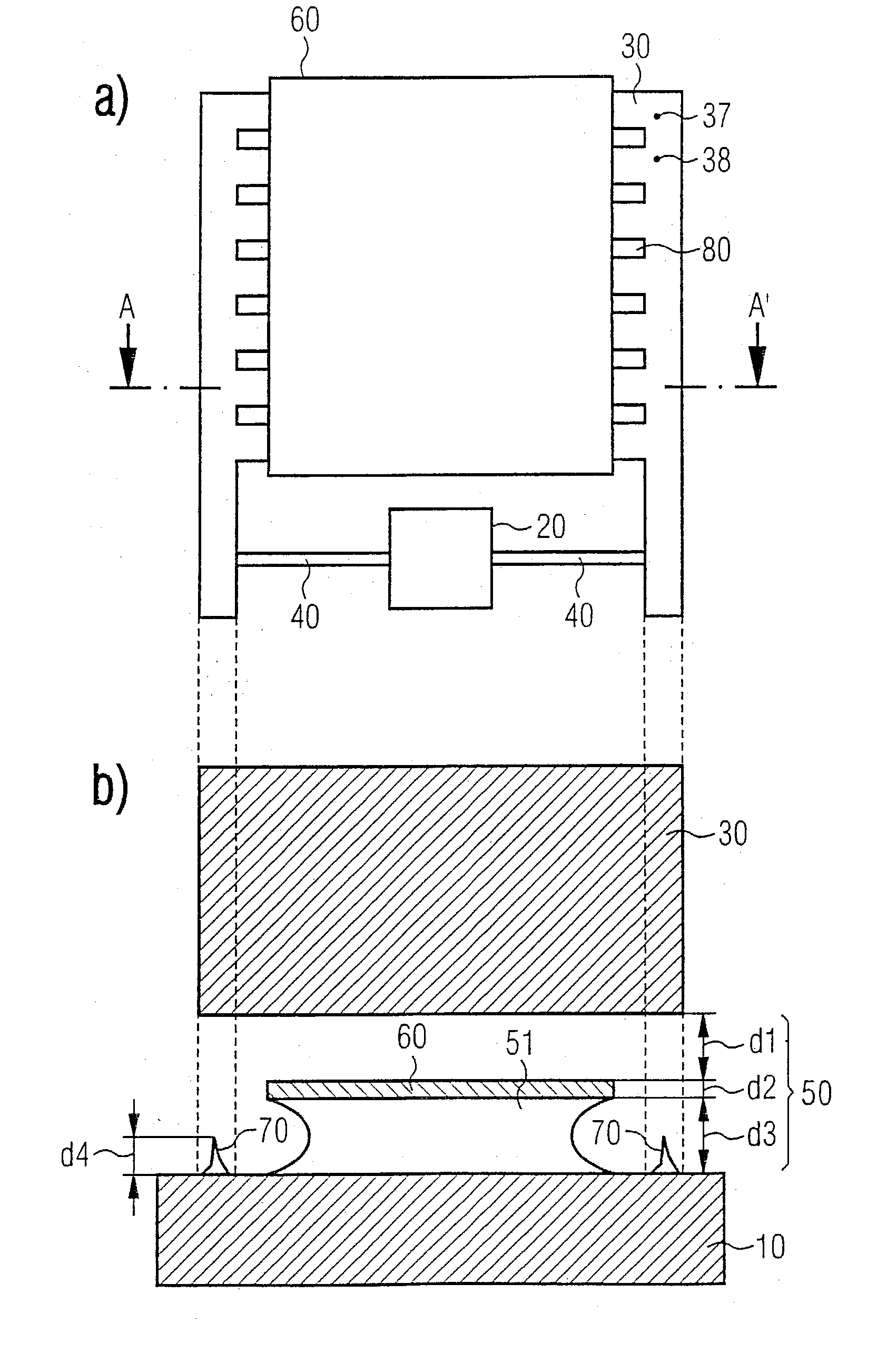Micromechanical structure, in particular for an acceleration sensor or yaw rate sensor and a corresponding method for producing the same
a micromechanical and sensor technology, applied in the direction of acceleration measurement using interia forces, instruments, coatings, etc., can solve the problems of reducing the mechanical functional area, ignoring the attention, and limiting the application of micromechanical structures
- Summary
- Abstract
- Description
- Claims
- Application Information
AI Technical Summary
Benefits of technology
Problems solved by technology
Method used
Image
Examples
first embodiment
[0043] FIG. 1 shows a schematic top view of the micromechanical structure according to the present invention in the form of a rocker structure; specifically, FIG. 1a shows a top view, and FIG. 1b shows a section along line A-A'.
[0044] The structure according to FIG. 1 includes a substrate 10, which has an anchoring device 20 and a centrifugal mass 20 in the form of a rocker having longitudinal and transverse bars and corresponding clearances 80, which is connected to anchoring device 20 via a flexible spring device 40, so that centrifugal mass 30 is elastically deflectable from its rest position.
[0045] As in the case of the structure according to FIG. 6, deflectability is implementable in this embodiment by etching sacrificial layer 50 situated under centrifugal mass 30. Sacrificial layer 50 has a lower sacrificial sublayer 51 and an upper sacrificial sublayer 52, between which electrode areas 60 are provided, which electrostatically cooperate with centrifugal mass 30.
[0046] In this...
second embodiment
[0052] FIG. 2 shows a schematic top view of the micromechanical structure according to the present invention in the form of a rocker structure; specifically, FIG. 2a shows a top view of a first bar geometry, and FIG. 2b shows a top view of a second bar geometry.
[0053] In the second embodiment according to FIG. 2a, a first electrode area 60a, a second electrode area 60b, and a conductive shielding electrode area 90 as electrically functional layers are located in the printed conductor plane under the electromechanically effective structures. The electromechanically functional components include longitudinal bars and transverse bars which connect them and which do not end or bend or intersect over the electrode areas of the printed conductor plane, i.e., 60a, 60b, 90. Corner points 37 and points of intersection 38 are located next to lower electrode areas 60a, 60b, 90.
[0054] The transverse bars are divided into groups running over a lower electrode area 60a, 60b, 90. Within a group, t...
third embodiment
[0056] FIG. 3 shows a schematic top view of the micromechanical structure according to the present invention in the form of a rocker structure.
[0057] In this additional embodiment, lower electrode surfaces 1, 2, 3 underneath the electromechanical structures may be divided, so that points of intersection 38 of the transverse bars of the upper functional layer are located above the clearances left open between lower electrode areas 60c-60h. In addition, electrode areas 60c, 60d, as well as 60e, 60f, and 60g are connected to one another in pairs via a printed conductor 61.
PUM
| Property | Measurement | Unit |
|---|---|---|
| thickness | aaaaa | aaaaa |
| thickness | aaaaa | aaaaa |
| angle | aaaaa | aaaaa |
Abstract
Description
Claims
Application Information
 Login to View More
Login to View More - R&D
- Intellectual Property
- Life Sciences
- Materials
- Tech Scout
- Unparalleled Data Quality
- Higher Quality Content
- 60% Fewer Hallucinations
Browse by: Latest US Patents, China's latest patents, Technical Efficacy Thesaurus, Application Domain, Technology Topic, Popular Technical Reports.
© 2025 PatSnap. All rights reserved.Legal|Privacy policy|Modern Slavery Act Transparency Statement|Sitemap|About US| Contact US: help@patsnap.com



